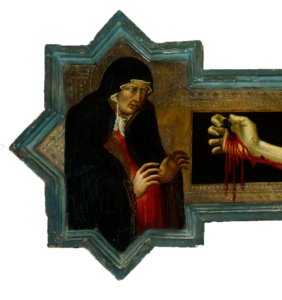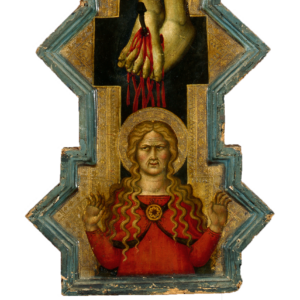Madonna and Child with Saints
Pietro Alemanno
Below the image, click play to listen.
Polychrome and giltwood, c. 1570
Unknown Spanish, 16th century
Renaissance artists employed various media and techniques to communicate their subject matter with power and beauty. This mid- to late-16th-century giltwood and polychrome relief by an unnamed artist (likely Spanish) demonstrates both artistic mastery and devotional power. It was once part of a larger altarpiece yet communicates clearly on its own.
A relief sculpture is normally attached to a background of the same material, and the degree of projection from that surface determines the terms used. Low relief, or bas-relief, project only a little. High relief denotes significant freedom from the background and can look like the figures are about to burst free from their surrounds. Finally, in sunken relief (or intaglio), subjects are carved below the level of their surroundings.
Gilding, the decorative technique of applying a thin layer of gold on a solid surface, dates back to Egypt. Herodotus mentions the Egyptians’ skill in gilding wood and metal, and many examples of their work remain to this day. The Sumerians (with objects dating back to 2600-2400 B.C.), Ancient Chinese, Old Testament Israelites, Ancient Greeks and Romans also utilized very thin sheets of hammered gold to overlay important objects of wood, stone and metal.
To produce fine furniture or sculpture, artists first carved plain woods like pine, beech or limewood. They then added numerous layers of gesso (a type of plaster made by mixing fine chalk or gypsum with animal glue and water). Initial applications of the gesso filled imperfections in the wood, and subsequent layers built up a smooth surface that could be carved with greater detail than wood and rendered a top layer that could be gilt, painted, or otherwise decorated. The depth and crispness of this final surface indicates the craftsman’s skill.
The quality of M&G’s relief sculpture shows gilding expertise, but its polychromy adds to its power. Polychrome (literally, “many colored”)—pigmented wood, stone or terracotta—also dates to Egypt and the process refined over time. Over the millennia artists employed a wide range of pigments, painting media, and surface applications to embellish their work, and specialization occurred.
In Spain, the production of religious sculptures was governed by designated guilds. The Guild of Carpenters carved the wood and gesso, and the Guild of Painters was responsible for all decoration. Specific terminology came to describe specific skills. After the pieces were carved, painters used flesh tones for hands, faces, and feet (a process called Encarnacion). Estofado, which means “quilted silk,” was the skill of simulating rich fabrics through the layering of gold or silver leaf.
M&G’s sculpture demonstrates mastery of all these skills in an emotionally intense representation of Jesus’ followers lowering Him from the cross. Christ is the central figure—emphasized both by His placement on a diagonal in the center and by the fact that He is the only figure painted entirely in flesh tones. Around Him gather His mother, Mary (on the right), Mary Magdalene (immediate left, her hair cascading over her shoulder), Mary’s sister, and Mary the wife of Clopas. Behind Jesus, the Apostle John (at Christ’s right shoulder) and Nicodemus (left shoulder) bear the weight of His body. To the far right, two men pry open a sarcophagus. On the far left, stands Joseph of Arimathea, who had asked Pilate for Jesus’ body and donated both his new grave and linen to wrap Christ’s body. His headwear denotes Joseph’s status as a member of the Sanhedrin, and the striped pattern etched on its gilding matches that on the long swath of linen he is showing to the two women beside him. Taut carving of the trees, leaves, and clothing bring the scene to life and gilt patterns play across the various fabrics, the tomb, and the background plants and clouds. All of these techniques coalesce to convey the grief and dedication of Christ’s followers.
At the devotional center, as in history, is Jesus Christ—His redemptive work done, His burial imminent, and His victory over death yet to come.
Dr. Stephen B. Jones, M&G Volunteer
Metmuseum.org
Nationalgallery.org.uk
Hall’s Dictionary of Subjects and Symbols in Art, James Hall
Understanding Paintings: Themes in Art Explored and Explained, Alexander Sturgis and Hollis Clayson
Published 2025
This depiction of St. John the Evangelist by the Master of Cueza provides an intriguing look at various accoutrements used by medieval scribes.
Tempera and gold on panel, c. 1380
Sienese, active c. 1356-1389
Among the many treasures in M&G’s collection hangs a unique and exemplary example of late fourteenth-century Italian art. In 1374, the Black Death struck the city of Siena and its surrounding countryside for the third time in twenty-six years. The return of the plague devastated the city, which was already struggling from political and economic instability. Tragically, most of the victims of this wave of the Black Death were children. In the wake of this period of grief, an unknown patron commissioned Sienese artist Francesco di Vannuccio to paint a crucifix or croce dipinta (painted cross) for his or her church. During the fourteenth century, large painted crucifixes were a fixture in Italian churches. They depicted Christ dead on the cross flanked by Mary and John the Evangelist and were often highly decorated in gold. Positioned above the altar, these crucifixes provided a focal point for worshippers.
Francesco’s patron included an unusual request: the image of Mary Magdalene facing out toward the worshipper with her hands raised in the ancient orans pose of prayer. Of the 214 surviving Italian fourteenth-century crucifixes, only fourteen have Mary Magdalene present. Of those, only one intact crucifix, M&G’s, features this extremely rare imagery of Mary Magdalene. With its unique depiction of a ministering female saint, Francesco’s crucifix was born out of the need for spiritual solace in the aftermath of the Black Death.
Little is known about Francesco di Vannuccio. Few of his paintings survive. He signed only one work, a double-sided panel now housed in Berlin’s Gemäldegalerie. Despite this small surviving body of work, all of Francesco’s paintings demonstrate that he possessed a keen eye for intricate decoration. He was also closely attuned to the religious concerns of his day. Francesco’s depictions of physical and emotional suffering made him stand out among his fellow artists. In his crucifix, Christ’s arms are pulled taut by the weight of His body. His fingers curl and His feet twist around the piercing nails. Blood spurts in a wide arc from the wound in His chest and drips from His head, hands, and feet. While other crucifixes show the mother of Christ serenely grieving, Francesco painted her face deeply lined in anguish. Poignantly, she reaches for her Son, something not seen in any other fourteenth-century crucifixes. Francesco’s Mary is a mother mourning the loss of her Child, a sight many worshippers would have personally related to following the third outbreak of the Black Death.
 Beneath Christ’s feet, Mary Magdalene prays. Despite being one of the most popular female saints during the fourteenth century, Mary Magdalene’s presence in crucifixes is rare. Most depict her small in scale contemplating the cross. She does not directly engage with the worshipper as Francesco’s does. During the fourteenth century, Mary Magdalene was revered both as the “blessed sinner” (tradition combined her with the repentant sinful woman in Luke 7) and as the “apostle to the apostles” because of her encounter with the resurrected Christ and her role of spreading the news to His other followers. Painting the blood flowing down to her head and her bright red robes, Francesco depicted Mary Magdalene as being baptized in Christ’s blood. With her hands raised in the orans position and facing the worshipper, Francesco also depicted her as the “apostle to the apostles.” The ancient orans pose represented the worshipper’s openness to God’s grace and was a gestural expression of faith in Christ’s death and resurrection. By the fourteenth century, this prayer position was reserved solely for the clergy. Thus, Francesco’s Mary Magdalene is an apostle actively ministering to the worshippers.
Beneath Christ’s feet, Mary Magdalene prays. Despite being one of the most popular female saints during the fourteenth century, Mary Magdalene’s presence in crucifixes is rare. Most depict her small in scale contemplating the cross. She does not directly engage with the worshipper as Francesco’s does. During the fourteenth century, Mary Magdalene was revered both as the “blessed sinner” (tradition combined her with the repentant sinful woman in Luke 7) and as the “apostle to the apostles” because of her encounter with the resurrected Christ and her role of spreading the news to His other followers. Painting the blood flowing down to her head and her bright red robes, Francesco depicted Mary Magdalene as being baptized in Christ’s blood. With her hands raised in the orans position and facing the worshipper, Francesco also depicted her as the “apostle to the apostles.” The ancient orans pose represented the worshipper’s openness to God’s grace and was a gestural expression of faith in Christ’s death and resurrection. By the fourteenth century, this prayer position was reserved solely for the clergy. Thus, Francesco’s Mary Magdalene is an apostle actively ministering to the worshippers.
Painting Mary Magdalene in this active role, Francesco and his patron were likely inspired by Catherine of Siena (1347-1380). Catherine was a writer and preacher who advocated spiritual reform. She was beloved for her piety and her healing the sick during the third wave of the Black Death. In her ministry, Catherine looked to Mary Magdalene as an example of religious devotion and service. Writing to her female followers, she urged them to “follow the Magdalen, that lovely woman in love, who never let go of the tree of the most holy cross. No, with perseverance she was bathed in the blood of God’s Son…she so filled her memory and heart and understanding with it that she became incapable of loving anything but Christ Jesus.” Mary Magdalene’s love for Christ drove her to brave the Roman soldiers guarding the tomb and proclaim the news of the Resurrection to anyone who would listen.
For worshippers living in the grief-filled years of the late fourteenth century, the sight of Mary Magdalene offered comfort both in the cleansing power of Christ’s sacrifice and His Resurrection. Almost six and a half centuries later, the message of Francesco di Vannuccio’s gleaming cross continues to resonate today.
Dr. Allison Wynne Raper, Adjunct Instructor at York Technical College
For further reading:
Ole J. Benedictow. The Complete History of the Black Death. Woodbridge, Suffolk: The Boydell Press, 2021.
Catherine of Siena. The Letters of Catherine of Siena. Translated by Suzanne Noffke, O.P. 4 Volumes. Tempe, AZ: Arizona Center for Medieval and Renaissance Studies, 2000-2008.
Katherine Ludwig Janson. The Making of the Magdalene: Preaching and Popular Devotion in Late Medieval Italy. Princeton: Princeton University Press, 2000.
Published 2024